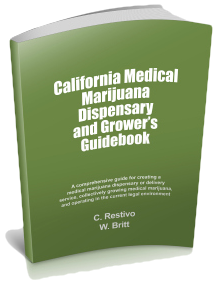California-Specific MMJ Laws
Proposition 64 – Adult Use of Marijuana Act (AUMA)
The Adult Use of Marijuana Act is a California marijuana legalization ballot initiative (Prop 64) that passed on November 8, 2016. In general, AUMA serves three basic functions.
(1) allows adults 21 years and older to possess up to one ounce of marijuana and cultivate up to six plants for personal use;
(2) regulates and taxes the production, manufacture, and sale of marijuana for adult use; and (a 15% excise tax on retail sales and an additional $9.25 per ounce of flower or $2.75 per ounce of
(3) rewrites criminal penalties by reducing the most common marijuana felonies to misdemeanors and allows prior offenders to petition for reduced charges.
 California Medical Marijuana Laws
California Medical Marijuana Laws
Proposition 215 – The Compassionate Use Act of 1996.
On November 5, 1996, California voters passed Proposition 215, which decriminalized the cultivation and use of marijuana by seriously ill individuals upon a physician’s recommendation. (§ 11362.5.) Proposition 215 was enacted to “ensure that seriously ill Californians have the right to obtain and use marijuana for medical purposes where that medical use is deemed appropriate and has been recommended by a physician who has determined that the person’s health would benefit from the use of marijuana,” and to “ensure that patients and their primary caregivers who obtain and use marijuana for medical purposes upon the recommendation of a physician are not subject to criminal prosecution or sanction.” (§ 11362.5(b) (1) (A)-(B).)
The Act further states that “Section 11357, relating to the possession of marijuana, and Section 11358, relating to the cultivation of marijuana, shall not apply to a patient, or to a patient’s primary caregiver, who possesses or cultivates marijuana for the personal medical purposes of the patient upon the written or verbal recommendation or approval of a physician.” (§ 11362.5(d).) Courts have found an implied defense to the transportation of medical marijuana when the “quantity transported and the method, timing and distance of the transportation are reasonably related to the patient’s current medical needs.” (People v. Trippet (1997) 56 Cal.App.4th 1532, 1551.)
Senate Bill 420 – The Medical Marijuana Program Act (MMP)
On January 1, 2004, Senate Bill 420, the Medical Marijuana Program Act (MMP), became law. (§§ 11362.7-11362.83.) The MMP, among other things, requires the California Department of Public Health (DPH) to establish and maintain a program for the voluntary registration of qualified medical marijuana patients and their primary caregivers through a statewide identification card system. Medical marijuana identification cards are intended to help law enforcement officers identify and verify that cardholders are able to cultivate, possess, and transport certain amounts of marijuana without being subject to arrest under specific conditions. (§§ 11362.71(e), 11362.78.)
This bill made it mandatory that all counties participate in the identification card program by (a) providing applications upon request to individuals seeking to join the identification card program; (b) processing completed applications; (c) maintaining certain records; (d) following state implementation protocols; and (e) issuing DPH identification cards to approved applicants and designated primary caregivers. (§ 11362.71(b).) Participation by patients and primary caregivers in the identification card program is voluntary. However, because identification cards offer the holder protection from arrest, are issued only after verification of the cardholder’s status as a qualified patient or primary caregiver, and are immediately verifiable online or via telephone, they represent one of the best ways to ensure the security and non-diversion of marijuana grown for medical use. In addition to establishing the identification card program, the MMP also defines certain terms, sets possession guidelines for cardholders, and recognizes a qualified right to collective and cooperative cultivation of medical marijuana.
Attorney General’s Medical Marijuana Guidelines (Aug 2008) ←Click Here
Federal Marijuana Law:
The federal Government still views marijuana as a Schedule I drug on par with cocaine and heroin.
Adopted in 1970, the Controlled Substances Act (CSA) established a federal regulatory system designed to combat recreational drug abuse by making it unlawful to manufacture, distribute, dispense, or possess any controlled substance. (21 U.S.C. § 801, et seq.; Gonzales v. Oregon (2006) 546 U.S. 243, 271-273.) The CSA reflects the federal government’s view that marijuana is a drug with “no currently accepted medical use.” (21 U.S.C. § 812(b) (1). Accordingly, the manufacture, distribution, or possession of marijuana is a federal criminal offense. (Id. at §§ 841(a) (1), 844(a).)
The Recent Evolution of the Federal Government’s View on Marijuana
In November 2012 Colorado passed Proposition 64 and Washington passed Initiative 502 making it legal for anyone over the age of 21 to possess marijuana and for businesses to sell it. This took some pressure off the California medical marijuana as the Feds had a bigger problem to deal with. The federal government was adamantly opposed to these initiatives and stated they would continue to enforce Federal marijuana laws. This feds were put in a difficult position and something had to give.
In August of 2013 the Justice Department issued a statement saying it won’t challenge state laws that legalize marijuana and will focus federal enforcement on serious trafficking cases and keeping the drug away from children. The US Attorney General notified the governors of Colorado and Washington and said they will not seek to pre-empt those states’ laws allowing recreational marijuana use.
Federal prosecutors were directed to refocus on eight enforcement priorities, including preventing marijuana distribution to minors, preventing drugged driving, stopping drug trafficking by gangs and cartels and forbidding the cultivation of marijuana on public lands.
For entities operating in the marijuana business, the government expects “robust controls and procedures that are effective in practice” (not just on paper). The size and profitability of these businesses will still be a factor prosecutors can consider, but there also must be additional illegal activities for prosecutors to take action.
With the recent legalizations in Colorado and Washington we are entering unchartered territory for marijuana industry and it is a great time to be a part of it. The federal government is to be backing off. In a January 2014 article in the New Yorker magazine President Obama stated that he didn’t “think (marijuana) was more dangerous than alcohol.” A few days later the deputy director of the White House’s Office of National Drug Control Policy, Michael Botticelli, reluctantly agreed.
On February 14th 2014 The U.S. Justice and Treasury departments issued guidance allowing financial services to work with legal marijuana businesses. The federal marijuana banking memo reiterated the eight areas of concern (or Cole memo priorities) we discussed above. This memo gives banks and credit card processers the “green” light to work with the evolving marijuana industry. As a byproduct, this guidance will provide MMJ business with access to many other auxiliary services such as payroll and various online transactions that were recently not accessible. On the other side of the coin, bring marijuana businesses into the banking system will make their financial information more accessible to the government.
For more on the Federal Government’s medical marijuna business banking policy’s visit The Financial Crimes Enforcement Network’s website.

